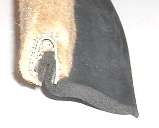The MGA With An Attitude
DOOR SEALS - Space and Fit -- INT-108C



 Where the door seals mount, the body flanges are supposed to be double layer 18-gauge steel, 0.048"x2 plus paint or about 0.1" thick. The furflex binding is nominally 0.5" wide as installed, or 0.2" either side of the body flange. The soft rubber seal is nominally 0.25" thick, and it will compress to 0.2" thick with door closed, if properly aligned. That is, the soft rubber compresses to same thickness as one side of the furflex, so the furflex touches the inner door trim panel when closed.
Where the door seals mount, the body flanges are supposed to be double layer 18-gauge steel, 0.048"x2 plus paint or about 0.1" thick. The furflex binding is nominally 0.5" wide as installed, or 0.2" either side of the body flange. The soft rubber seal is nominally 0.25" thick, and it will compress to 0.2" thick with door closed, if properly aligned. That is, the soft rubber compresses to same thickness as one side of the furflex, so the furflex touches the inner door trim panel when closed.
The trim panel measures 0.15" thick with the vinyl covering wrapped around the edges. So the gap between body flanges and steel door inner shell wants to be nominally 0.35" wide before installation of any trim. I would call the tolerance +/-.03", making the desired range of gap width 0.38"/0.32" (3/8" max. to 5/16" min. gap range) for a very snug seal. When in doubt, set it up to be on the wide side (up to 1/2"). You can squeeze it a bit by door adjustment after assembly if needed for better sealing.
See details of the original type furflex seal on the prior page. See also Installation Instructions from Clarke Spares and Restorations. The Clarke Spares instructions call for the gap (steel to steel) to be 1/2", and says it is common for the gap to be wider at the front. If you have irregular gap, then I'd say make the widest space no more than 1/2".
If you have more than two layers of sheet metal after body repair work, the furflex will stretch wider (up to 3 layers), but the side gap requirement is still the same. If you have non-standard aftermarket door seal, all bets are off. The seal I had installed in 1986 was too thick and interfered badly with closing of the door. The seal I got from Clarke Spares in 2001 (installed in 2006) is as original and perfect fit. I think Moss Motors sells the same seal as Clarke Spares now (just have to assemble it yourself).
In reality, by the time you get this far you may not have much choice in width of the gap for the door seal. Position of the front and rear fenders may more or less dictate lateral position of the door for flush panels on the outside. If you're lucky you should end up with about 3/8 inch gap to accommodate the bulk of the door seal. If the gap is too small you might have to leave the door a bit loose with the outer skin protruding a bit beyond the fenders. If the gap is a bit too large the door seal may not seal properly, resulting in a bit of road dust intrusion, or a little cool breeze in cold weather. It is a primary function of a good door seal to accommodate a fairly wide range of body gap to compensate for a multitude of irregularities in panel alignment. To have more accurate control over this body gap you have to start much earlier in the assembly process, when the individual panels of the main body structure are being aligned before spot welding.
|